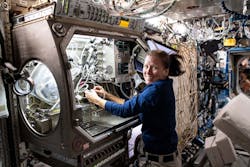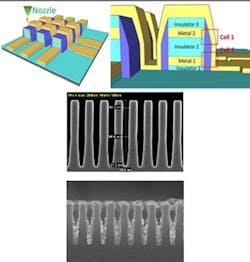ASU and NASA collaborate on space-based semiconductor manufacturing
Earth’s gravity adds extra steps to semiconductor manufacturing, so researchers at Arizona State University Ira A. Fulton Schools of Engineering are working with NASA and other academic and industry collaborators to build a blueprint for manufacturing microelectronics in space.
Ying-Chen (Daphne) Chen, an assistant professor of electrical engineering at ASU and Curtis Hill, a senior materials engineer at NASA are leading the project with funding from the CHIPS and Science Act and NASA’s In Space Production Applications program. A variety of industry collaborators, including Tokyo Electron America, Axiom Space, Intel and Fujifilm, are also involved in the research. On the academic side, the research team includes Iowa State University Associate Professor of materials science and engineering Shan Jiang and University of Wisconsin – Madison Assistant Professor of industrial and systems engineering Hantang Qin.
Manufacturing semiconductor devices in space has the potential to reduce long and costly steps in the manufacturing process, specifically for 3D oxide-based resistive random-access memory (RRAM) devices. These 3D devices differ from traditional 2D RRAM devices by stacking layers of memory storage cells vertically, instead of a traditional flat arrangement, allowing for a smaller footprint and more memory storage in a single device.
The project wants to harness the reduced pressure from microgravity in space to eliminate the need for etching, a step in which trenches are deepened in a chip’s surface to make sufficient room for its conductive metal contacts.
Etching is required in Earth-based semiconductor manufacturing processes due to the need for a thicker layer of semiconductor wafer thin film material to compensate for pressure from gravity. The researchers hypothesize a slimmer thin film layer can be used in space due to the lack of gravity, resulting in a trench already made deep enough during manufacturing to render etching unnecessary.
“To manufacture a chip, companies normally need many steps in a clean room on Earth,” said Chen, a faculty member in the School of Electrical, Computer and Energy Engineering, part of the Fulton Schools. “The goal for this project is to realize ‘all-in-one’ printing with a printer capable of manufacturing 3D stacking structures, active layers and metals.”
Using these semiconductor printing devices, which have a much smaller footprint than a fabrication facility on Earth, would reduce the time needed to manufacture a 3D RRAM device and do away with the need for large amounts of personal protective equipment.
“For future commercialized manufacturing, more transportation companies will join space shipping efforts, reducing cost and increasing competitiveness,” Chen said. “I see many of these technologies, or high-speed automated versions of them, eventually in small, low Earth orbit factories to build a semiconductor ecosystem in space for chip manufacturing and characterization.”
Hill says the research intends to develop the manufacturing method to enable industry to regain U.S. electronics industry prominence.
“We strongly believe the use of low Earth orbit and microgravity is a game-changing technology that will enable the U.S. to take the lead in semiconductor manufacturing,” he says. “We hope to ultimately drive the advancement of the U.S.’ semiconductor manufacturing ability and to develop a space economy for it.”


